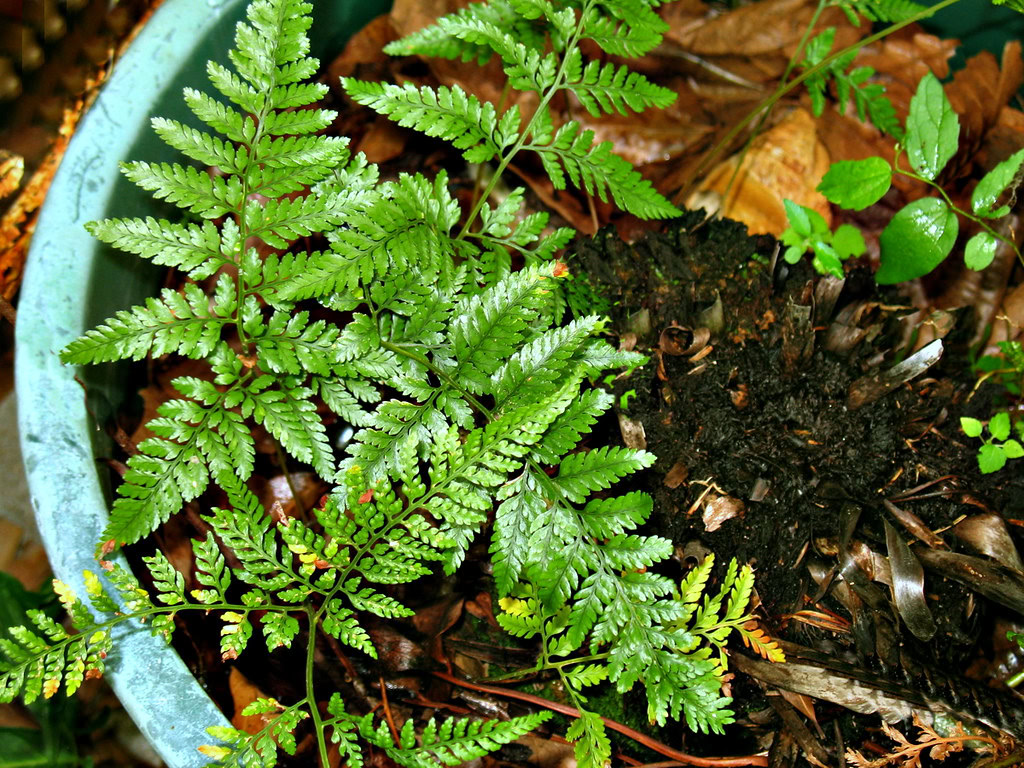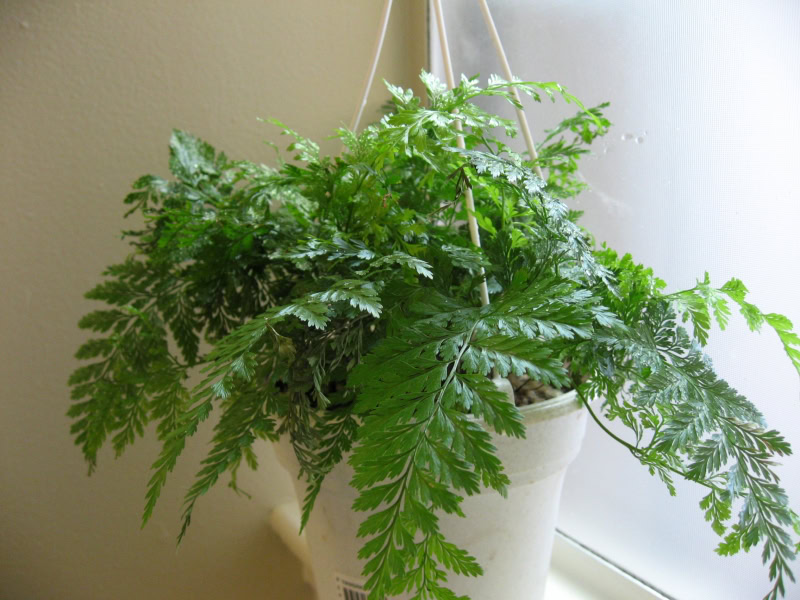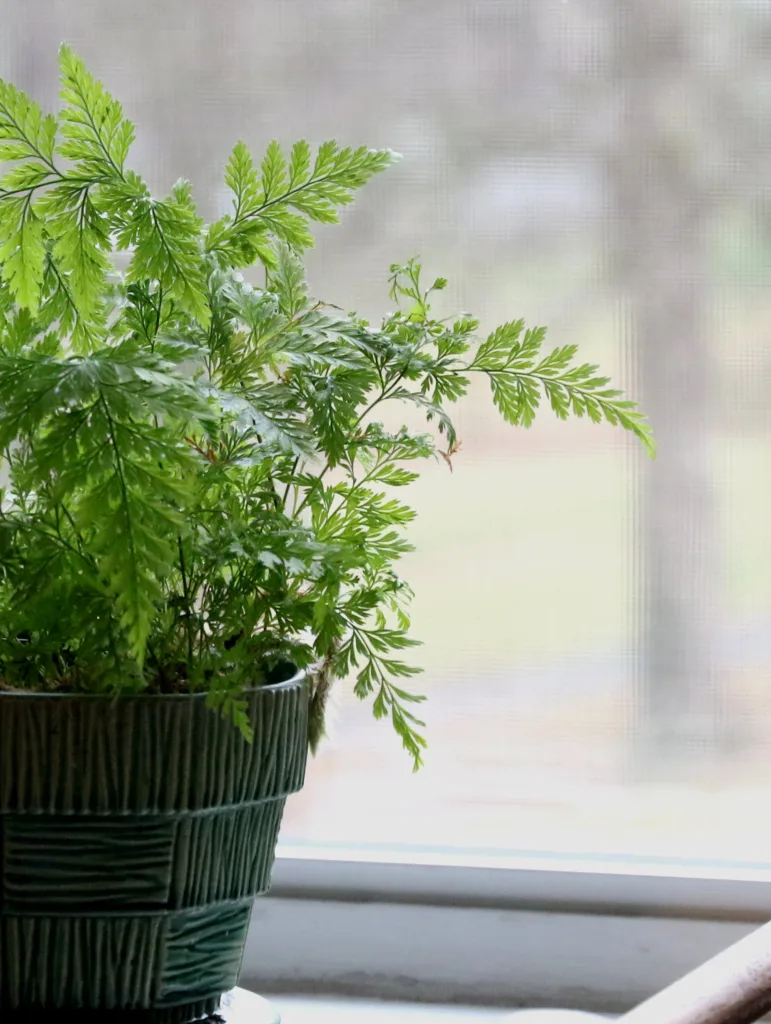The Rabbit Foot Fern, scientifically known as Davallia fejeensis, is a distinctive and attractive fern species characterized by its unique rhizomes that resemble the hairy feet of a rabbit.
Native to the Pacific Islands, Southeast Asia, and Hawaii, rabbit foot fern blooms in tropical and subtropical regions.
If you’re looking to add a touch of elegance to your indoor garden, look no further than the rabbit foot fern.
Well-suited for hanging baskets or elevated planters to showcase its trailing, fuzzy rhizomes. With its delicate, furry leaves and unique growth pattern, this plant is sure to capture anyone’s heart.
Physical Characteristics:
- The Rabbit’s Foot Fern is recognized for its finely textured fronds that radiate from a central point, creating an attractive and delicate appearance.
- The most distinctive feature is its hairy, creeping rhizomes that run up the sides of the container, resembling the soft feet of a rabbit.
| Taxonomic Rank | Classification |
|---|---|
| Kingdom | Plantae |
| Division | Pteridophyta |
| Class | Pteridopsida |
| Order | Polypodiales |
| Family | Davalliaceae |
| Genus | Davallia |
| Species | fejeensis |

Choosing the Right Spot for Your Rabbit Foot Fern
When it comes to the rabbit foot fern, finding the right spot is crucial for its overall health and growth. Here are a few things to keep in mind:
Light: Rabbit foot ferns thrive best in bright, indirect light. Avoid placing them in direct sunlight as it can scorch their delicate fronds. A north-facing window or a spot away from direct sunlight would be perfect.
Temperature: These ferns prefer temperatures between 60°F and 75°F (15-24°C). Avoid placing them near drafts or areas with temperature fluctuations, such as near air conditioners or heaters.
Humidity: High humidity is vital for the rabbit foot fern to thrive. If your home tends to be dry, consider using a humidifier or placing a tray filled with water near the plant to increase moisture in the air.
The Right Soil and Pot for Your Rabbit Foot Fern
Choosing the correct soil and pot for your rabbit foot fern is essential for its growth and well-being. Follow these guidelines:
Soil: Rabbit foot ferns prefer a well-draining soil that retains moisture without becoming waterlogged. A mix of peat moss, perlite, and a small amount of sand creates an optimal growing medium. It’s also a good idea to add organic matter to the soil for additional nutrients.
Potting: Select a pot that has drainage holes to prevent water from accumulating at the roots. The pot size should be slightly larger than the previous one, allowing room for growth. Avoid using pots significantly larger than necessary, as it can lead to overwatering and root rot.
Watering Your Rabbit Foot Fern
Proper watering is crucial for the health of your rabbit foot fern. Follow these watering guidelines to ensure optimal growth:
Water Frequency: Rabbit foot ferns prefer consistently moist soil. Water the plant when the top inch of the soil feels slightly dry to the touch. Avoid overwatering, as it can lead to root rot, and under-watering, which can cause the fern to dry out.
Water Quality: These ferns are sensitive to chemicals commonly found in tap water, such as chlorine and fluoride. To avoid harm, use filtered or distilled water, or allow tap water to sit overnight to allow the chemicals to dissipate.
Humidity: Misting the fronds with water can help increase humidity and prevent them from drying out. However, avoid misting the furry rhizomes, as they can rot if consistently wet.
Fertilizing Your Rabbit Foot Fern
Although rabbit foot ferns are not heavy feeders, providing them with the right nutrients is essential for their growth and vibrancy. Here’s how to fertilize your fern effectively:
Fertilizer Type: Use a balanced, water-soluble fertilizer formulated specifically for ferns. Look for a fertilizer with an NPK ratio of 20-20-20 or a slightly lower nitrogen content to prevent burning the delicate fronds.
Fertilizer Frequency: During the growing season, which typically starts in spring and continues through summer, feed your rabbit foot fern every four to six weeks. Reduce fertilization during winter when growth slows down.
Application Method: Dilute the fertilizer according to the instructions on the packaging, and apply it to the soil around the fern. Avoid getting the fertilizer directly on the fronds or furry rhizomes, as it can cause burns.
Propagating Your Rabbit Foot Fern
If you’re a fan of sharing plants or simply want to expand your rabbit foot fern collection, propagation is an excellent way to do so. Here’s how to propagate your fern successfully:
Stolon Division: Rabbit foot ferns produce creeping stems called stolons, which develop new plants at their ends.
To propagate through stolon division, locate a mature stolon with healthy fronds and roots. Carefully cut it away from the parent plant, ensuring each new plant has its own set of roots.
Plant the new divisions in a suitable pot with well-draining soil, taking care not to bury the furry rhizomes.
Rhizome Division: Another method of propagation is through rhizome division. Carefully remove the fern from its pot, and gently separate the rhizomes, making sure each division has healthy fronds and roots. Plant each division in its pot, following the same soil and potting guidelines mentioned earlier.

Common Issues and Troubleshooting
Despite your best efforts, your rabbit foot fern may encounter a few common issues. Here are a few troubleshooting tips to help you address them:
Wilting Fronds: Wilting fronds are often a sign of underwatering or inadequate humidity. Check the soil moisture levels and adjust your watering accordingly. Consider misting the fronds or placing a humidifier nearby to boost humidity.
Brown or Yellow Fronds: Brown or yellow fronds can indicate overwatering, underwatering, or exposure to direct sunlight. Ensure that you’re watering your fern correctly and keeping it in a suitable light environment.
Pests: Rabbit foot ferns are generally resistant to pests. However, keep an eye out for common houseplant pests such as aphids, mealybugs, and spider mites. If you notice any infestations, treat them promptly with insecticidal soap or neem oil.
Conclusion
Growing and caring for a rabbit foot fern can be a rewarding experience. From finding the perfect spot with bright, indirect light to the right watering and fertilization routine, each step plays a vital role in the overall health and growth of your fern.
Remember to maintain adequate humidity, choose suitable soil and pots, and be attentive to any signs of issues your plant may be facing.
With proper care, your rabbit foot fern will thrive, adding a touch of natural beauty to your indoor space. So go ahead, give it a try, and enjoy watching your fern flourish!
FAQs
How do you take care of a rabbit’s foot fern?
Rabbit’s Foot Ferns require well-draining soil, indirect light, and high humidity. Keep the soil consistently moist, but not soggy, and provide regular misting for humidity.
Do rabbit foot ferns like sun or shade?
Rabbit’s Foot Ferns prefer indirect or filtered light. They thrive in low to medium light conditions, making them suitable for shaded areas.
Is a rabbit foot fern poisonous?
Rabbit’s Foot Ferns are generally non-toxic and safe for pets. However, it’s always advisable to keep plants out of reach of curious pets.
What is the common name for rabbit foot fern?
The Rabbit’s Foot Fern is commonly known by its nickname “Rabbit’s Foot” due to the furry rhizomes that resemble a rabbit’s foot.

